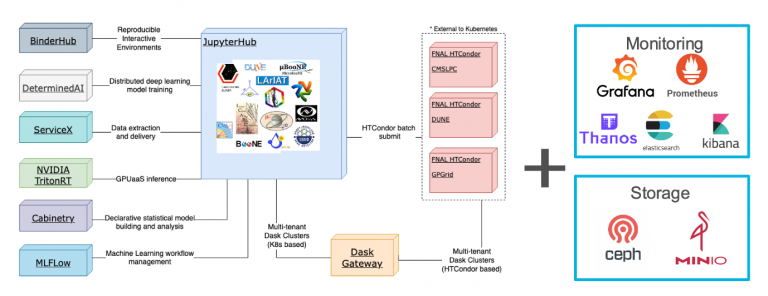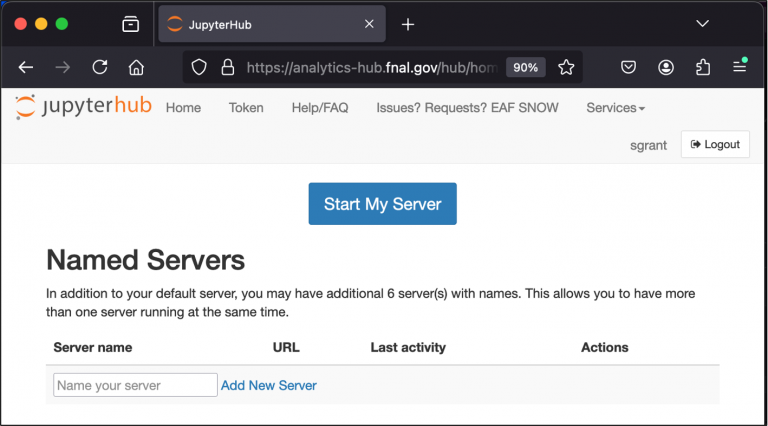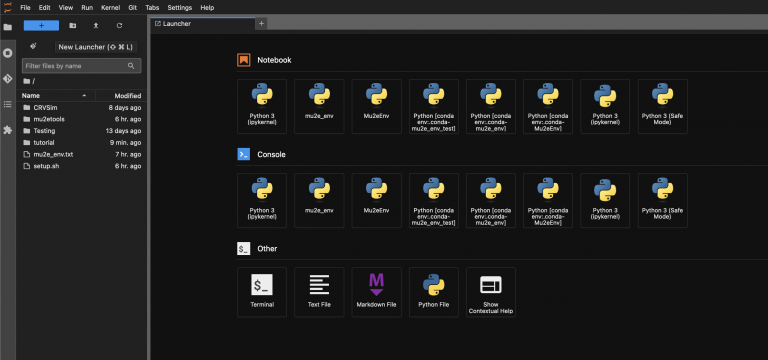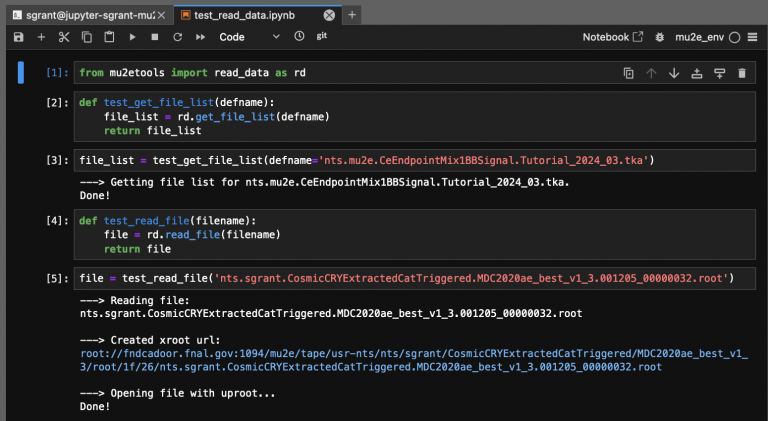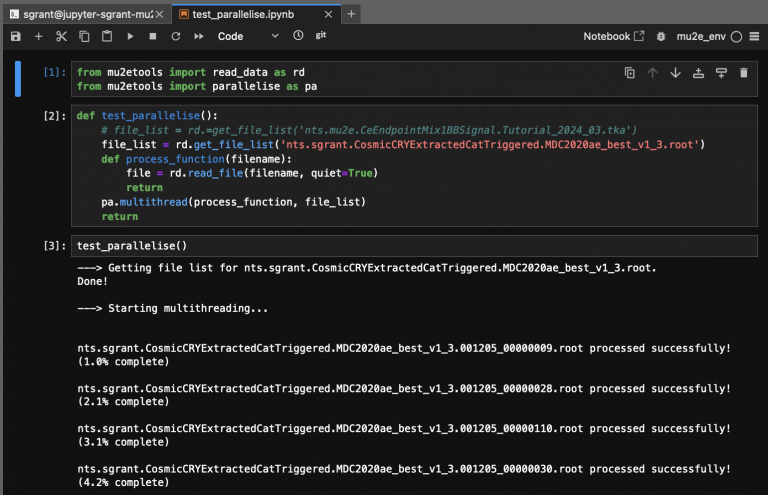Elastic Analysis Facility (EAF): Difference between revisions
(Created page with "Category:EAF category:Introduction = Introduction = This page is intended as a guide to the Fermilab Elastic Analysis Facility (EAF) for Mu2e collaborators. The off...") |
|||
| Line 55: | Line 55: | ||
Once you have started your proxy server and <code>ssh</code> tunnel (if you are off-site), go the EAF home page at | Once you have started your proxy server and <code>ssh</code> tunnel (if you are off-site), go the EAF home page at | ||
https://analytics-hub.fnal.gov | https://analytics-hub.fnal.gov | ||
you should see a welcome page | on which you should see a welcome page which will invite you to sign in with your Fermilab Services (SSO) account. | ||
sign in | |||
Make sure you're using the same browser as the one you have configured to use a proxy! You should see a page with a <code>Start My Server</code> button. If you click on this button it will take you to a <code>Server Options</code> page. | Make sure you're using the same browser as the one you have configured to use a proxy! You should see a page with a <code>Start My Server</code> button. If you click on this button it will take you to a <code>Server Options</code> page. | ||
| Line 84: | Line 80: | ||
[[Category:EAF]] [[ category:JupterHub and the EAF area]] | [[Category:EAF]] [[ category:JupterHub and the EAF area]] | ||
= JupterHub and the EAF area = | = JupterHub and the EAF area = | ||
Revision as of 16:20, 23 August 2024
Introduction
This page is intended as a guide to the Fermilab Elastic Analysis Facility (EAF) for Mu2e collaborators. The official EAF documentation from SCD can be found at https://eafjupyter.readthedocs.io/en/latest/.
EAF is a web-based platform intended for Python analysis and ML tasks. The key to EAF is the container-based infrastructure, which distinguishes it from traditional virtual machines. The benefit of this approach is that underlying resources (the hardware) can be swapped without breaking the container, adding elasticity.
EAF is a a powerful and flexible platform, ideal for running Mu2e Python analyses and ML tasks.
Accessing EAF
EAF is entirely web-based, that is, there is no interactive ssh access at present. This means that in order to access EAF from outside the FNAL network you will either need to use the Fermilab VPN, or set up a proxy. You will also need an active services account.
There are number of ways to set up a proxy. One method, which is endorsed by SCD and should be applicable to all operating systems, is use Firefox with some modified network settings. Instructions on how to do this are given below.
- Ensure you have a valid kerberos ticket: check with
klist, runkinit <username>@FNAL.GOVto make a new one. Make sure to replace<username>with your FNAL username. - Open a terminal and start an
sshtunnel to an FNAL machine on which you have an account (such asmu2egpvm01).ssh -f -N -D 9999 <username>@mu2egpvm01.fnal.gov
- Open Firefox and type
about:configinto the address bar, click OK to ignore the warning. - Use the search bar to change the parameters by to the values shown in the table below.
| Parameter | Value |
|---|---|
| network.proxy.socks | 127.0.0.1 |
| network.proxy.socks_port | 9999 |
| network.proxy.socks_remote_dns | true |
| network.proxy.type | 1 |
To stop the proxy, change network.proxy.type back to its default value by pressing the reset button to the right of the edit button.
See https://library.fnal.gov/off-site-electronic-access-instructions for more information.
Starting an EAF server
Once you have started your proxy server and ssh tunnel (if you are off-site), go the EAF home page at
https://analytics-hub.fnal.gov
on which you should see a welcome page which will invite you to sign in with your Fermilab Services (SSO) account.
Make sure you're using the same browser as the one you have configured to use a proxy! You should see a page with a Start My Server button. If you click on this button it will take you to a Server Options page.
Follow the instructions below to start an AL9 server.
- Go to the
FIFEserver box:
- Click
CPU Interactives. - Select
AL9. - Scroll down to bottom of the page and click
Start.
The server may take a few minutes to start up. You will see a page like this
There is also an option to start a server from a Mu2e AL9 image, which is now deprecated. Instead, it is recommended to use the mu2e_env environment described in The Mu2e environment.
JupterHub and the EAF area
On loading an EAF server you be land on a JupyterHub launcher page. From here you should see various options to applications such as a terminal, a python notebook, a python file editor, or an interactive python console. It also provides options run the interactive applications with different Python kernels, where kernels represent both the execution engine and the packages, libraries, and dependencies available to the Python interpreter. You can also access these options by clicking the blue "+" button on the top right.
If you open a terminal and run pwd, you will see that a user area has been automatically created for you in /home. From here, you have direct access to the /exp/mu2e/app and /exp/mu2e/data areas. Access to /pnfs requires xroot, which is included in the mu2e_env environment described in The Mu2e environment.
Each user has eight guaranteed cores, a 64 GB memory limit, and 23 GB of storage on their EAF user area.
Conda/Mamba
Conda and Mamba are open-source packages and environment management systems. Mamba is simply a C++ reimplementation of Conda: it has the same command syntax but is supposed to be more efficient. Mamba is the tool used in this example to set up our Mu2e environment, and can be used to create and manage custom user environments.
Upon initialising, Mamba will write some lines to your $HOME/.bashrc files, so first make sure that your $HOME/.bash_profile is set up to read from the .bashrc by adding the following lines to your .bash_profile using any command line text editor (such as emacs or vim).
# Get aliases and functions
if [ -f ~/.bashrc ]; then
. ~/.bashrc
fi
To start using Mamba, again using a terminal from the JupyterHub launcher, and initialise Mamba as shown below.
mamba init
This will prompt you to open a new shell, so close the current session and start a new one.
You only need to do this once.
The Mu2e environment
Custom environments allow for flexibility beyond the base image, which is managed by SCD. To provide users with the tools needed to conduct analysis, we have an installed a Python environment on /exp/data that can used on by EAF and the virtual machines. This will eventually be moved to the /cvmfs area.
To use this environment, create a symlink in your EAF .conda directory that points to the environment, as shown below.
ln -s /exp/mu2e/data/users/sgrant/EAF/env/mu2e_env ~/.conda/envs/mu2e_env
You can then activate the environment using mamba.
mamba activate mu2e_env
Once inside the environment, you have access to the libraries listed below.
matplotlib pandas uproot scipy scikit-learn pytorch tensorflow jupyterlab notebook statsmodels awkward urllib3==1.26.16 ipykernel conda-pack fsspec-xrootd mu2etools==0.0.1
To use these packages interactively, you can install an ipython kernel in your user area with following command.
python -m ipykernel install --user --name mu2e_env --display-name "mu2e_env"
You should then see mu2e_env appear as an option when launching a notebook or interactive console.
If you prefer, you can to install a copy of the environment locally from the environment YMAL file. This method should allow you to customise the environment if needed.
mamba env create -f /exp/mu2e/data/users/sgrant/EAF/env/mu2e_env/environment.yml mamba activate mu2e_env
In any case, you should now see (mu2e_env) as a prefix on your command line.
(mu2e_env) [<username>@jupyter-<username> ~]$
To you this environment on the Mu2e virtual machines, you can use the activate/deactivate scripts in the environment directory directly. So, to activate:
source /exp/mu2e/data/users/sgrant/EAF/env/mu2e_env/bin/activate
and to deactivate:
source /exp/mu2e/data/users/sgrant/EAF/env/mu2e_env/bin/deactivate
It also might be convenient to alias this command in your .my_bashrc file, to something like
alias activate_mu2e_env="source /exp/mu2e/data/users/sgrant/EAF/env/mu2e_env/bin/activate" alias deactivate_mu2e_env="source /exp/mu2e/data/users/sgrant/EAF/env/mu2e_env/bin/deactivate"
Custom environments
To start entirely from scratch, you can create a clean custom environment with the commands below.
mamba create -q -y -n my_env mamba activate my_env
You can then install whatever packages you need using mamba install <package_name>.
mu2etools
Along with some standard Python libraries, mu2e_env contains a set of custom tools defined in https://github.com/sam-grant/mu2etools.git. This contains some generalised methods from Yuri Oksuzian's https://github.com/oksuzian/mu2etools.
At present, mu2etools allows users to interface with SAM and /pnfs from EAF, and provides a multithreading tool. These are tools can be imported as packages from mu2etools called read_data and parallelise.
Before reading files, you will need a valid access token/certificate. Run the following:
source /cvmfs/mu2e.opensciencegrid.org/setupmu2e-art.sh
kinit ${USER}@FNAL.GOV
/cvmfs/mu2e.opensciencegrid.org/bin/vomsCert
To create a file list from a SAM dataset:
from mu2etools import read_data as rd file_list = rd.get_file_list(defname='nts.mu2e.CeEndpointMix1BBSignal.Tutorial_2024_03.tka')
To read a file from /pnfs using xroot:
from mu2etools import read_data as rd file = rd.read_file(filename='nts.sgrant.CosmicCRYExtractedCatTriggered.MDC2020ae_best_v1_3.001205_00000000.root')
An example of read_data in use is shown below. The read_data functions also include a quiet flag to suppress their printouts, if needed.
To run parallel reads on a list of files using multithreading, run:
from mu2etools import parallelise as pa
def process_function(filename):
file = rd.read_file(filename, quiet=True)
return
pa.multithread(process_function, file_list)
An example of parallelise in use is shown below.
More tools will be added as needed.
